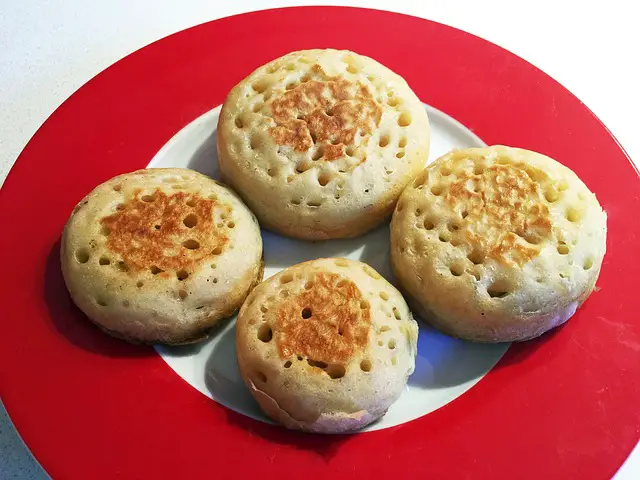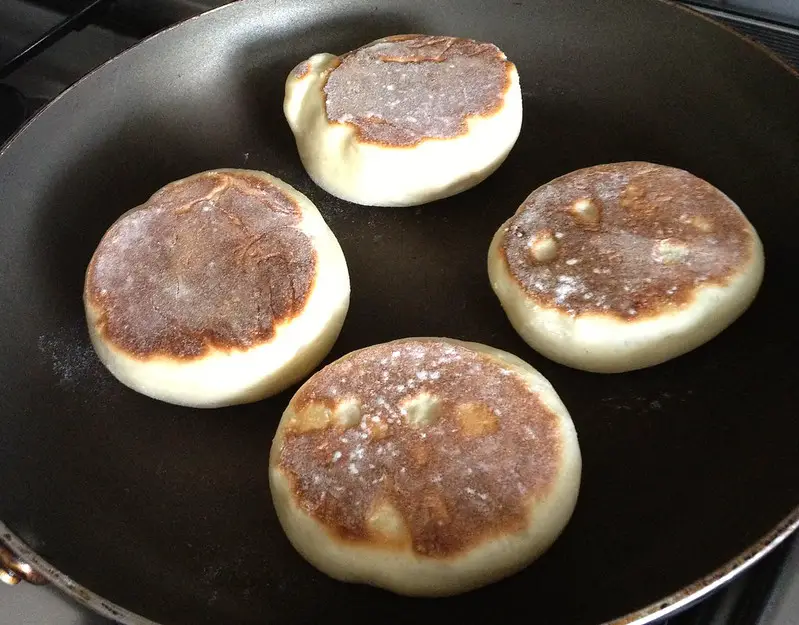English muffins are a type of yeast-leavened bread that is cooked on a griddle and often split and toasted before serving. English crumpets, on the other hand, are a type of griddle cake made with a batter of flour, yeast, and baking soda, and have a distinctive porous texture with a slightly sweet and tangy flavor.
History of English muffins

The English muffin is a yeast-leavened bread that is cooked on a griddle. The dough is made with flour, milk, water, and yeast. It is rolled out thin and then cut into rounds with a biscuit cutter. The rounds are then cooked on a griddle until they are golden brown.
The English muffin has its origins in England, where it was first made in the early 1800s. It became popular in the United States in the mid-19th century. The English muffin was originally called the toaster crumpet or the breakfast cup. It was not until the early 20th century that the name English muffin was first used.
History of English crumpets
(Image by istara from Pixabay )

The English crumpet has a long and storied history. The first known recipe for a crumpet dates back to the early 18th century, and was likely inspired by similar recipes from across Europe. Crumpets were originally made with a very simple batter of flour, water, and yeast. The dough was then cooked on a griddle or in a pan, resulting in a thick and spongy cake.
Over time, the recipe for English crumpets evolved to include milk, eggs, and butter, which helped to create a more tender and flavorful crumpet. Modern day crumpets are often leavened with baking powder or baking soda in addition to yeast, which helps them to rise more quickly and evenly.
English crumpets are traditionally served with butter and jam, or honey. They can also be enjoyed on their own as a quick snack or light meal. Whether you’re enjoying a classic English crumpet or one of the many delicious variations now available, there’s no doubt that this humble treat is truly one of England’s national treasures!
English muffins Vs. Crumpets – Key Differences
English muffins and English crumpets are both traditional British breakfast foods, but they are actually quite different. Here are some key differences between the two:
Texture: English muffins have a denser texture and are more bread-like, while crumpets are lighter and have a spongy texture with lots of small holes on the surface.
Shape: English muffins are round and flat, while crumpets are round and thicker with a slightly curved edge.
Cooking method: English muffins are usually cooked on a griddle or in a frying pan and then finished in the oven, while crumpets are only cooked on a griddle or in a special crumpet pan.
Ingredients: English muffins are made with flour, yeast, salt, and milk or water, while crumpets are made with flour, yeast, salt, and water, and also include baking soda for extra rising.
Serving suggestions: English muffins are often split in half and toasted, then served with butter and jam or as part of a breakfast sandwich. Crumpets are usually toasted, then topped with butter and honey or jam, and sometimes served with cheese or cold cuts.
English muffins and crumpets are delicious breakfast treats, but they have distinct differences in texture, shape, cooking method, ingredients, and serving suggestions.
How to make English muffins?
Here’s a recipe for making English muffins:
Ingredients:
- 3 cups all-purpose flour
- 1 tablespoon sugar
- 1 1/2 teaspoons salt
- 1 tablespoon active dry yeast
- 1/4 cup warm water
- 1/4 cup warm milk
- 1/2 cup warm water
- Cornmeal for dusting
Instructions:
- In a large mixing bowl, whisk together the flour, sugar, and salt.
- In a separate small bowl, dissolve the yeast in 1/4 cup warm water.
- Add the yeast mixture to the dry ingredients along with the 1/4 cup warm milk and 1/2 cup warm water. Stir to combine and form a sticky dough.
- Knead the dough on a floured surface for about 10 minutes, until smooth and elastic.
- Place the dough in a clean bowl, cover with plastic wrap, and let rise in a warm place for about 1 hour, until doubled in size.
- Preheat a griddle or frying pan over medium heat and sprinkle with cornmeal.
- Roll out the dough to about 1/2 inch thickness and cut into rounds using a cookie cutter or the rim of a drinking glass.
- Place the rounds on the griddle or frying pan, dust the tops with cornmeal, and cook for about 5 minutes on each side, until golden brown and cooked through.
- Split the muffins in half and toast in a toaster or under the broiler.
- Serve with butter, jam, or as part of a breakfast sandwich.
Enjoy your freshly made English muffins!
How to make English crumpets?
Here’s a recipe for making English crumpets:
Ingredients:
- 2 cups all-purpose flour
- 1 teaspoon sugar
- 1 teaspoon salt
- 1 1/2 teaspoons active dry yeast
- 1 1/4 cups warm water
- 1/4 teaspoon baking soda
- Butter for greasing
Instructions:
- In a large mixing bowl, whisk together the flour, sugar, and salt.
- In a separate small bowl, dissolve the yeast in 1/2 cup of the warm water.
- Add the yeast mixture to the dry ingredients along with the remaining 3/4 cup warm water. Stir to combine and form a sticky batter.
- Cover the bowl with plastic wrap and let rise in a warm place for about 1 hour, until bubbly and doubled in size.
- In a small bowl, dissolve the baking soda in 1 tablespoon of warm water.
- Gently stir the baking soda mixture into the batter until just combined.
- Grease a crumpet pan or frying pan with butter and heat over medium-low heat.
- Spoon the batter into the pan, filling each crumpet ring about halfway.
- Cook for about 8-10 minutes, until the tops are set and the bottoms are golden brown. Use a spatula to carefully remove the crumpets from the pan and transfer them to a wire rack to cool.
- Repeat with the remaining batter, greasing the pan with butter as needed.
- Once the crumpets are cool, toast them under the broiler or in a toaster.
- Serve with butter, honey, jam, or as desired.
Which is better English muffin or crumpet?
There are a few key differences between English muffins and crumpets. For one, English muffins are made with baking soda and baking powder, while crumpets are made with only baking powder. This gives English muffins a slightly more cake-like texture, while crumpets are more dense and chewy.
English muffins also have a more distinct flavor than crumpets. Crumpets tend to be bland, while English muffins have a slightly tangy flavor. This is due to the addition of malt in the batter for English muffins.
So which is better? That really depends on your personal preference. If you like a light, fluffy texture, then English muffins are probably your best bet. If you prefer a denser, chewier texture, then crumpets might be more up your alley. And if you’re looking for something with more flavor, English muffins definitely have the edge over crumpets.
Are English muffins and crumpets healthy?
Both English muffins and crumpets can be part of a healthy diet, but like any food, their nutritional value depends on the ingredients and how they are prepared.
English muffins are usually made with flour, yeast, salt, and milk or water, and can be a good source of complex carbohydrates, protein, and fiber. However, some store-bought English muffins may contain added sugars, preservatives, and other additives, so it’s important to check the label and choose a brand that uses wholesome ingredients.
Crumpets are typically made with the same basic ingredients as English muffins, but also include baking soda for extra rising. Like English muffins, they can be a good source of complex carbohydrates and fiber. However, they tend to be higher in sodium than English muffins, which may be a concern for people with high blood pressure or other health issues.
Both English muffins and crumpets are usually low in fat and calories, but the way you prepare them can also affect their overall nutritional value. Toasting and topping them with butter or jam can add calories and fat, while serving them with protein-rich foods like eggs or cheese can make them a more balanced meal.
In conclusion, English muffins and crumpets can be part of a healthy diet when consumed in moderation and prepared with wholesome ingredients and toppings.









